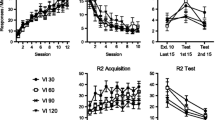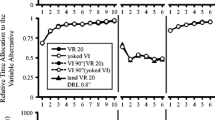Summary
Squirrel monkeys were trained under fixed-ratio (FR) or fixed-interval (FI) schedules in which the reinforcer was the termination of auditory and visual stimuli associated periodically with the presentation of brief, electric shocks. Methylphenidate, at several doses, exerted selectively different effects upon overall rates of responding engendered by the two types of schedule. The drug suppressed overall rates of responding maintained by FR50 in one monkey and FR250 in another; over the same range of doses, methylphenidate increased the overall rates of responding maintained by a FI schedule in two other animals.
Different local rates of responding were affected differentially since methylphenidate increased the low, near-zero rates of responding observed following a time out under both FR and FI schedules, (the effect being more pronounced for the FI than the FR schedules) but, by contrast, suppressed the higher (terminal) rates of responding preceding a time out (the effect being more pronounced for the FR- than for the FI-controlled performances).
Chronic pretreatment with reserpine (0.3 mg/kg for 10 days), given to two monkeys, progressively reduced the overall rates of responding maintained by the fixed-interval schedule; the rate-suppressive effect of reserpine was antagonized at a dose of 2 mg/kg of methylphenidate in both animals. One monkey, subjected to pretreatment with reserpine, died after an injection of 4 mg/kg methylphenidate; the dosage at 4 mg/kg consistently antagonized the effects of reserpine in the other animal. The resulting pattern of behavior more closely resembled the effects of methylphenidate given alone than control performances recorded in the absence of drug treatment, suggesting that the antagonistic effects of a sympathomimetic amine, such as d-amphetamine, upon reserpine-induced changes in behavior may be a more general phenomenon that can be demonstrated with various rate-enhancing drugs, including methylphenidate.
Similar content being viewed by others
References
Bernstein, B. M., and L. P. Cancro: The effect of two variables of avoidance conditioning on drug-behavior interaction. Psychopharmacologia (Berl.) 3, 105–113 (1962).
Cook, L., and A. C. Catania: Effects of drugs on avoidance and escape behavior. Fed. Proc. 23, 818–835 (1964).
Dews, P. B.: Modification by drugs of performance on simple schedules of positive reinforcement. Ann. N. Y. Acad. Sci. 65, 268–281 (1956).
—: Studies on behavior: IV. Stimulant actions of methamphetamine. J. Pharmacol. exp. Ther. 122, 137–147 (1958a).
Dews, P. B.: Analysis of effects of psychopharmacological agents in behavioral terms. Fed. Proc. 17, 1024–1030 (1958b).
—, and W.H. Morse: Behavioral pharmacology. Ann. Rev. Pharmacol. 1, 145–174 (1961).
Fry, W., R. T. Kelleher, and L. Cook: A mathematical index of performance on fixed-interval schedules of reinforcement. J. exp. Anal. Behav. 3, 193–199 (1960).
Gollub, L. R., and J. V. Brady: Behavioral pharmacology. Ann. Rev. Pharmacol. 5, 235–262 (1965).
Kelleher, R. T., W. Fry, J. Deegan, and L. Cook: Effects of meprobamate on operant behavior in rats. J. Pharmacol. exp. Ther. 133, 271–280 (1961).
—, and W. H. Morse: Escape behavior and punished behavior. Fed. Proc. 23, 808–817 (1964).
— —: Determinants of the specificity of behavioral effects of drugs. Ergebn. Physiol. 60, 1–56 (1968).
McMillan, D. E.: Some interactions between sympathomimetic amines and aminedepleting agents on the schedule-controlled behavior of the pigeon and the squirrel monkey. J. Pharmacol. exp. Ther. 163, 172–187 (1968).
Mechner, F., and M. Latranyi: Behavioral effects of caffeine, methamphetamine, and methylphenidate in the rat. J. exp. Anal. Behav. 6, 331–342 (1963).
Morse, W. H., and R. J. Herrnstein: Effects of drugs on characteristics of behavior maintained by complex schedules of intermittent positive reinforcement. Ann. N. Y. Acad. Sci. 65, 303–317 (1956).
—, and R. T. Kelleher: Schedules using noxious stimuli: 1. Multiple fixed-ratio and fixed-interval termination of schedule complexes. J. exp. Anal. Behav. 9, 267–290 (1966).
Owen, J. E.: The influence of dl-, d-, and l-amphetamine and d-methamphetamine on a fixed-ratio schedule. J. exp. Anal. Behav. 3, 293–309 (1960).
Rutledge, C. O., and R. T. Kelleher: Interactions between the effects of methamphetamine and pentobarbital on operant behavior in the pigeon. Psychopharmacologia (Berl.) 7, 400–408 (1965).
Schuster, C. R., and J. Zimmerman: Timing behavior during prolonged treatment with dl-amphetamine. J. exp. Anal. Behav. 4, 327–380 (1961).
Sidman, M.: Drug-behavior interaction. Ann. N. Y. Acad. Sci. 65, 282–302 (1956).
Smith, C. B.: Enhancement by reserpine and α-methyl dopa of the effects of d-amphetamine upon the locomotor activity of mice. J. Pharmacol. exp. Ther. 142, 343–350 (1963).
—: Effects of d-amphetamine upon operant behavior of pigeons: enhancement by reserpine. J. Pharmacol. exp. Ther. 146, 167–174 (1964).
Stolk, J. M., and R. H. Rech: Amphetamine-induced stimulation of locomotor activity of rats treated with reserpine. J. Pharmacol. exp. Ther. 158, 140–149 (1967).
— —: Enhanced stimulant effects of d-amphetamine in rats treated chronically with reserpine. J. Pharmacol. exp. Ther. 163, 75–83 (1968).
Stretch, R., and D. Dalrymple: Effects of methylphenidate, pentobarbital and reserpine on behavior controlled by a schedule of interresponse time reinforcement. Psychopharmacologia (Berl.) 13, 49–64 (1968).
Author information
Authors and Affiliations
Additional information
This work was supported by Grant APA-159 from the National Research Council of Canada. Thanks are due to Dr. C. W. Murphy of Ciba Ltd., Montreal for kindly providing supplies of methylphenidate (Ritalin) and reserpine (Serpasil) for this work.
Rights and permissions
About this article
Cite this article
Stretch, R., Skinner, N. Fixed-ratio and fixed-interval control of responding, using noxious stimuli: Effects of methylphenidate and reserpine. Psychopharmacologia 16, 89–104 (1969). https://doi.org/10.1007/BF00403612
Received:
Revised:
Issue Date:
DOI: https://doi.org/10.1007/BF00403612




